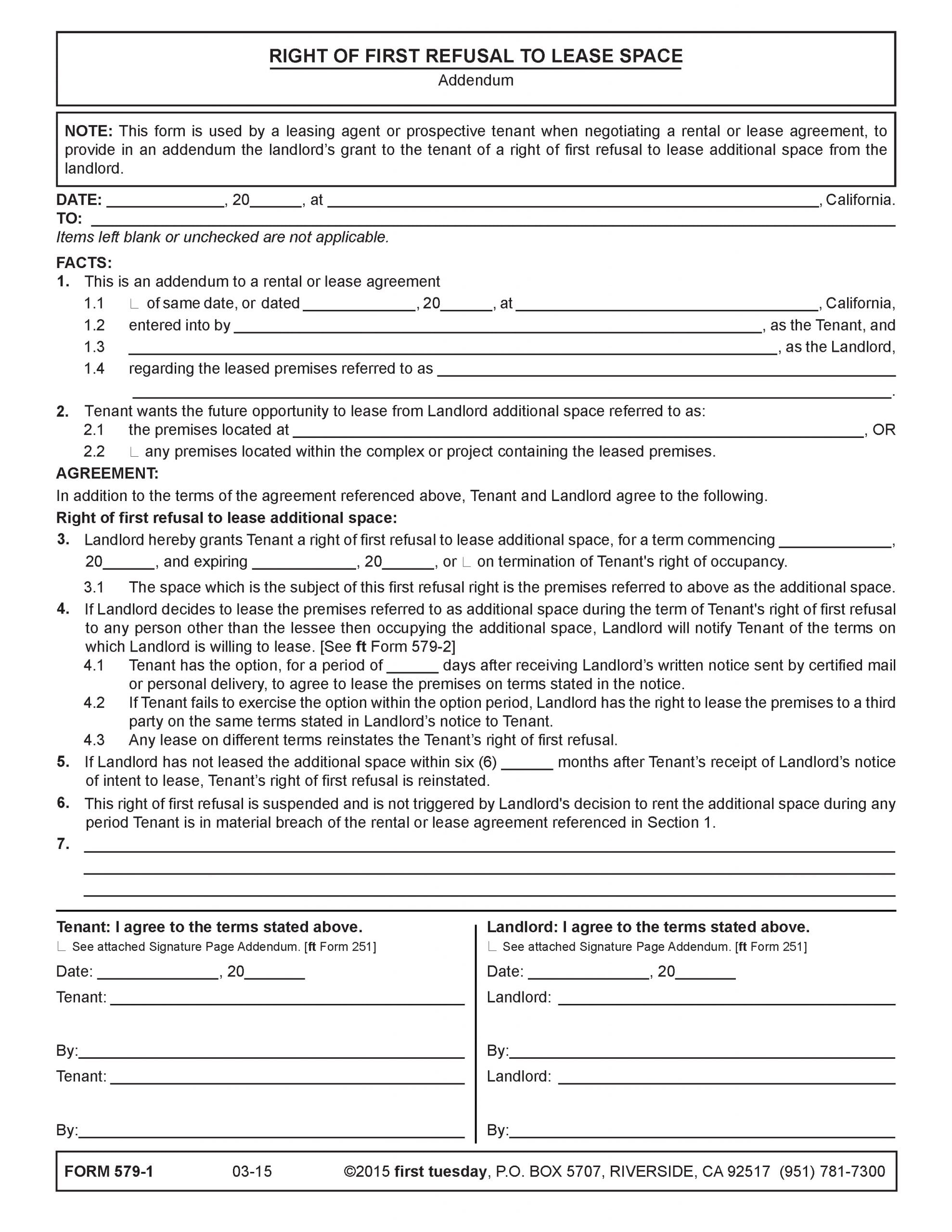This form is used by a leasing agent or prospective tenant when negotiating a rental or lease agreement, to provide in an addendum the landlord’s grant to the tenant of a right of first refusal to lease additional space from the landlord.
Seller’s motives
In a right of first refusal agreement, also called a preemptive right to buy, the decision to sell or not to sell is entirely within the seller’s discretion. Until the seller makes the decision to sell, the buyer has no right to purchase the property.
Once triggered by the seller’s affirmative decision to sell their property, the first refusal right results in a purchase option no different from any other. The buyer has the unconditional right to either buy or not buy the property within a fixed period, called an acceptance or exercise of the right of first refusal.
The seller’s reasons for granting the buyer a first refusal may vary. Possible motives for delaying the decision to sell include:
- tax benefits, such as wishing to delay the reporting of profit from a sale until a year when the profit can be offset by losses on the sale or operation of other properties;
- financial imperatives, such as wanting to delay the sale of the property to attain the highest price possible due to a rising market, leasing negotiations, rehab or rezoning;
- legal problems, such as a lis pendens or toxic cleanup hindering the sale of the property; and
- personal concerns, such as not being ready to sell the property for health, family or personal reasons.
Finally, the owner may simply have no intention to ever sell the property. Here, the buyer might request a right of first refusal on the theory the owner may someday change their mind as their needs and preferences evolve.
Ultimately, the right of first refusal allows the seller to avoid an enforceable commitment to sell or buy real estate.
Exercising the right of first refusal
The period following the notice of the seller’s intent to sell controls the buyer’s actions. Until notice of the seller’s intent to sell is given to the buyer, the buyer does nothing but wait to see whether the owner decides to sell.
Most disputes concerning the right of first refusal arise when the seller accepts another buyer’s offer. When another buyer makes an offer on the property which the seller accepts or counters, the seller is required to notify the holder of the first refusal right of the terms of the sale.
The holder of the preemptive right then either agrees to match the backup offer within the fixed period or waive the right of first refusal.
The right of first refusal is not the same as an option. Under an option, the buyer may require the seller to sell the property, but the right of first refusal only gives the buyer a chance when the owner decides to sell.
Similarly, a landlord subject to a right of first refusal held by a tenant is obligated to notify the tenant of the terms of any sales listing, option to buy, offer to purchase, counteroffer or acceptance of an offer to purchase which triggers the tenant’s right to buy under the right of first refusal provision. [See RPI Form 579]
A tenant who decides to purchase the property needs to then agree to match the sales term within the time period set in the right of first refusal provision. Failure to do so is a failure to exercise their right of first refusal, resulting in a loss of their right to buy.
The tenant’s performance under the right of first refusal does not need to be identical in all aspects to the buyer’s offer. However, the tenant’s offer needs to be financially equivalent to the buyer’s offer.
To exercise the right of first refusal, the tenant needs to agree to match the sales terms set by the landlord within the time period set in the right of first refusal provision.
Analyzing the Right of First Refusal to Lease
A leasing agent or prospective tenant uses the Right of First Refusal to Lease Space form published by RPI when negotiating a rental or lease agreement, to provide, in an addendum, the landlord’s grant to the tenant of a right of first refusal to lease additional space from the landlord. [See RPI Form 579-1]
The Right of First Refusal to Lease Space permits the tenant and landlord to agree to the following:
- the commencement of the term the landlord is granting the tenant and the expiration, either on termination of the tenant’s right of occupancy or a specified date [See RPI Form 579-1 §3];
- when the landlord decides to lease the premises referred to as additional space during the term of the tenant’s right of first refusal to any person other than the lessee then occupying the additional space, the landlord will notify the tenant of the terms on which the landlord is willing to lease with a Notice of Decision to Sell or Lease Additional Space form [See RPI Form 579-2; See RPI Form 579-1 §4]
- the number of days the tenant has the option to agree to lease the premises on terms stated in the notice received from the landlord by certified mail or personal delivery [See RPI Form 579-1 §4.1];
- when the tenant fails to exercise the option within the option period, the landlord has the right to lease the premises to a third party on the same terms stated in the landlord’s notice to the tenant [See RPI Form 579-1 §4.2]; and
- any lease on different terms reinstates the tenant’s right of first refusal [See RPI Form 579-1 §4.3]
The tenant and landlord then sign the form, binding them to the agreed terms.
Form navigation page published 07-2021.
Form last revised 2015.
Form-of-the-Week: Right of First Refusal to Buy and Right of First Refusal to Lease – Forms 579 and 579-1
Word-of-the-Week: Right of First Refusal
Article: The right of first refusal
Recent Case Decision: Does an owner hold a right of first refusal to recover property an agency takes by condemnation when the property is not used for its intended purpose within 10 years?
Recent Case Decision: Does a right-of-first refusal granted in a lease agreement survive when the lease ends and the tenant continues possession on a month-to-month basis?














